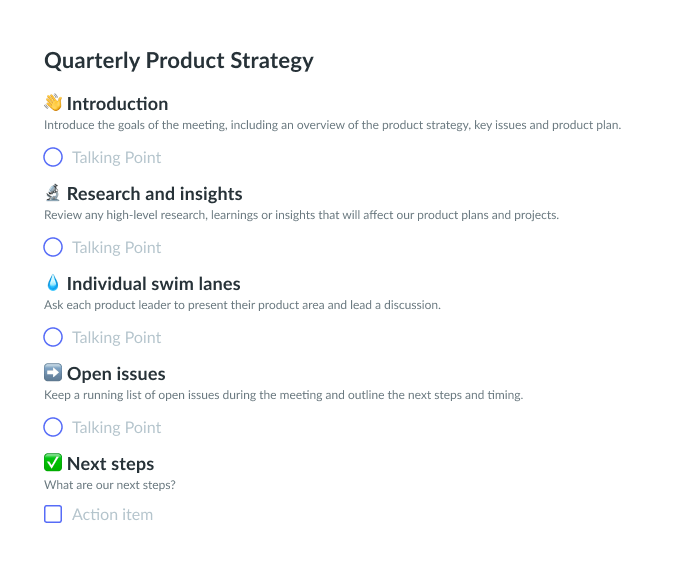Everybody who has been privy to product development meetings wants to improve them to some degree. Or get rid of them altogether.
We can’t blame you. Product management meetings are often long, boring, unorganized, and ineffective. At their worst, they drain your time and energy, leave you confused, and make you less productive and creative than when you first entered the meeting.
However, that’s just when they’re done badly. There are ways to spice up your product development meetings so you’ll come out of them feeling energized and raring to go.
Before we get onto the tips for improving your product development meetings, let’s take a look at what meetings product managers actually have in their busy schedule.
@tldv.io Makes perfect sense. #meeting #comedy #corporate #meetings #9to5 #firstday
♬ original sound - tldv.io - AI Meeting Recorder
3 Common Product Development Meetings for Product Managers
Product managers usually have a lot of meetings. Too many. To make them more efficient, it’s good to have a product development meeting agenda or template that you can use as a crutch for your meetings. This will help you stay on track and be far more effective with your time.
Here are the 3 most common product development meetings that a product manager will need to attend, and usually lead. While they’re sure to attend other meetings with stakeholders, management, and for other bits and bobs or perhaps with product management consulting services, these 3 are likely the most common, and arguably the most important.
1. Product Strategy Meeting
A what? A product strategy meeting is an explorative meeting to discuss all things product strategy, including checking up on progress and performance. These meetings also discuss new goals for the business and how to achieve them.
Who should participate? Product management, leadership, and relevant stakeholders will all have key inputs to a product strategy meeting.
Who should lead? It’s not called a product strategy meeting for nothing. Product managers should take the helm here as it’s their strength.
How often should they be? Depending on the needs of your business, every quarter or biannually.
How long should they take? Again, it depends on the complexity of the business and product, but a product strategy meeting will usually be at least 2 hours, often requiring multiple sessions.
What should be covered? During a product strategy meeting, there are several things to consider. Make sure you clearly cover them all so everybody is on the same page (so long as they’re relevant to you and your business):
- Market overview
- Revisit the company vision
- Progress on current goals, including new features or releases
- Performance metrics with financial data included
- Roadmaps, future targets, and areas of investment
- The needs and hurdles of the business
- Decisive new action points and goals (or revamping efforts on previous goals)

Source: Quarterly Product Strategy Meeting Template | Fellow.app
2. Product Launch Meeting
A what? A product launch meeting, or product kickoff, is a meeting to discuss the release of a new product. Frequently action-based, these meetings cover exactly what’s being built, by whom, in what time frame, how the features will work, and the immediate next steps for everyone involved.
Who should participate? Depending on the scope of the launch, it could be limited to product leads and management, or it could include stakeholders and even user researchers.
Who should lead? The product manager will be the one organizing and leading the product kickoff meeting,
How often should they be? Depending on your release schedule, they can be weekly, biweekly, or even monthly. The quicker you make progress, the more often you should touch base with your teammates.
How long should they take? Between 1 and 2 hours is a good bet for product release meetings.
What should be covered? Here are several things to cover in a product launch meeting:
- Target market and their needs
- Overview of the new release’s functionality: how it works, how long it will take, and the benefits for both user and business
- UX walkthroughs
- Feedback, criticisms, and a time for raising questions
- A GTM (go-to-market) strategy to align all team members
- Review your product launch checklist (if you haven’t got one, then check below)
- New action points and clear goals
3. Weekly Review
A what? A weekly review is where the product development team comes together to discuss and review progress on business goals. It’s a time to address any problems that have arisen.
Who should participate? Product management, project management, product marketing, developers or engineers, sales teams, and user researchers are all frequent candidates. Basically anybody related to the development of the product.
Who should lead? The product manager should lead, but this may vary depending on the specific focus of each review.
How often should they be? Usually they’re weekly, but there is no hard and fast rule. You can make them biweekly if it works for your business.
How long should they take? About one hour is usually enough for a regular review.
What should be covered? In weekly reviews, the following topics should usually be touched upon, if not the center of attention:
- Progress towards business goals
- Product roadmap review
- Recently completed work
- Upcoming goals and planned work
- New and important user feedback
- New opportunities
- Potential delays
5 Awesome Tips for Improving Product Development Meetings
Now you know the main gist of these product management meetings, let’s look at how we can enhance them so that you can be more efficient and productive.
1. Ask Yourself: Do You REALLY Need This Meeting?

At tl;dv, we’re strong believers that all meetings should be optional. This might sound like a huge spanner in the works for an unequipped team, but with the right meeting recorder, you can catch up on all the important things in seconds, focusing your energy on actually building the product instead of talking about it for 40 hours per week.
@tldv.io If the answer is already recorded, why are you asking me?? #workfromhome #corporatehumor #meetingrecordings
♬ original sound - tldv.io - AI Meeting Recorder
With that said, the list of meeting participants should be kept to a minimum, with only those that absolutely have to attend the meeting being there. Each of the people that need to be there should be invited with a clear explanation as for why their attendance is necessary.
Ask yourself: is a meeting really necessary? Is there a clear reason for it? And can that reason not be conveyed via some other means, like a virtual message or a Loom video? You might want to consider your team’s wages – especially those that don’t need to talk. They will be sitting there, half-listening, when they could be working on something important.

All non-essential participants can catch up with tl;dv’s nifty timestamp feature, or you can create a short reel from the meeting and share it instantly on Slack or your work chat of choice as soon as the call has ended. They won’t miss a thing.
Take a leap of faith and embrace the async nature of modern meetings. People are working from all over the globe. Respect their time (and their time zones) and let them catch up later if it’s not essential for them to present something. By mastering async meetings, you can skip the back-to-back meeting lifestyle and be sure that you’ll maintain an effective product team.
In addition to avoiding the timesuck of being in meetings all day, product managers can watch calls from user researchers to stay close to the customer during a busy season. You can also use tl;dv’s AI-powered search tool to find the topic you need in seconds.
2. Recap and Emphasize Action Points at the End of a Meeting
There’s nothing better at keeping everyone on track than emphasizing action points and making everything crystal clear for your team at the end of each call. While you’ll naturally cover all the important points during your meeting, especially if you’re following one of our templates above, it’s important to refresh the most important points at the end.
Your team will leave the call knowing what they have to do next, and by the time the next meeting rolls around, you can start with recaps and progress reviews of all the action points listed at the end of the previous meeting.
To really ensure that every participant knows what to focus on next, it’s a good idea to document the meeting in a transparent and easily accessible way, like with tl;dv. This way, not only can non-participants check up on the important parts of the meeting, but the participants can refresh themselves and check over the action points again to rejuvenate their focus. tl;dv is great for meeting summaries because AI will pinpoint obvious questions, action points and takeaways, while the timestamper tool lets anyone manually highlight meeting insights too.
3. Send a Post-Meeting Recap
You know how we mentioned emphasizing the action points at the end of the call? Well, do it again after the meeting.
While you don’t want to become annoying and patronizing, you do want to make each team member’s focus as clear as the night sky in the Atacama Desert. Everyone needs to be on the same page with irrefutable action points to fall back on if they forget or feel confused.
If someone wants to double check what they should be doing, or if another colleague missed the meeting for whatever reason, they should have a single source of truth to fall back on.
tl;dv, often used as a UX research repository for user interviews, can help. After the meeting ends, you can merge the various timestamps – one of them being the action points at the end – into highlight reels, and send the shorter clip to everyone via email or Slack.
Gone are the days where meeting efficiency could only be achieved within the meeting itself. Send a recap after every meeting and there is no possible way of not being clear on what everybody’s next task is.
4. Gather Post-Meeting Feedback and Insights
Not everybody thinks of the right thing to say mid-meeting. Sometimes they need time to let the creative juices simmer. If you encourage insights from your meeting participants, even after the meeting has ended, you’ll get far better feedback than if you were to limit the insight time to the call only.
Ideas take time to formulate, and not everybody is a public speaker. Leave your door open to post-meeting insights, and that’s exactly what you’ll get.
5. Play Devil’s Advocate
If the meeting starts to sound like a gathering of yes-men, you need to start playing devil’s advocate. It’s not going to be very efficient if there’s pure agreement. Ideas are strengthened under criticism.
Even if you are fully supportive of a certain idea or goal, try to position yourself on the other side of the spectrum. Raise objections, even if they sound silly. Don’t be afraid to get talking about the idea in more depth. Spice things up a bit.
If you don’t play devil’s advocate every now and then, your team could fall under the spell of bias, and that could lead everyone to agree with everything because you all have a preconceived idea of what your user wants and how you can best give it to them. Nip it in the bud early and your product development meetings will see a sharp incline in effectiveness.
Check out the Mom Test for a great way to avoid bias in user research. It can also be tweaked for presenting new ideas to your team.





